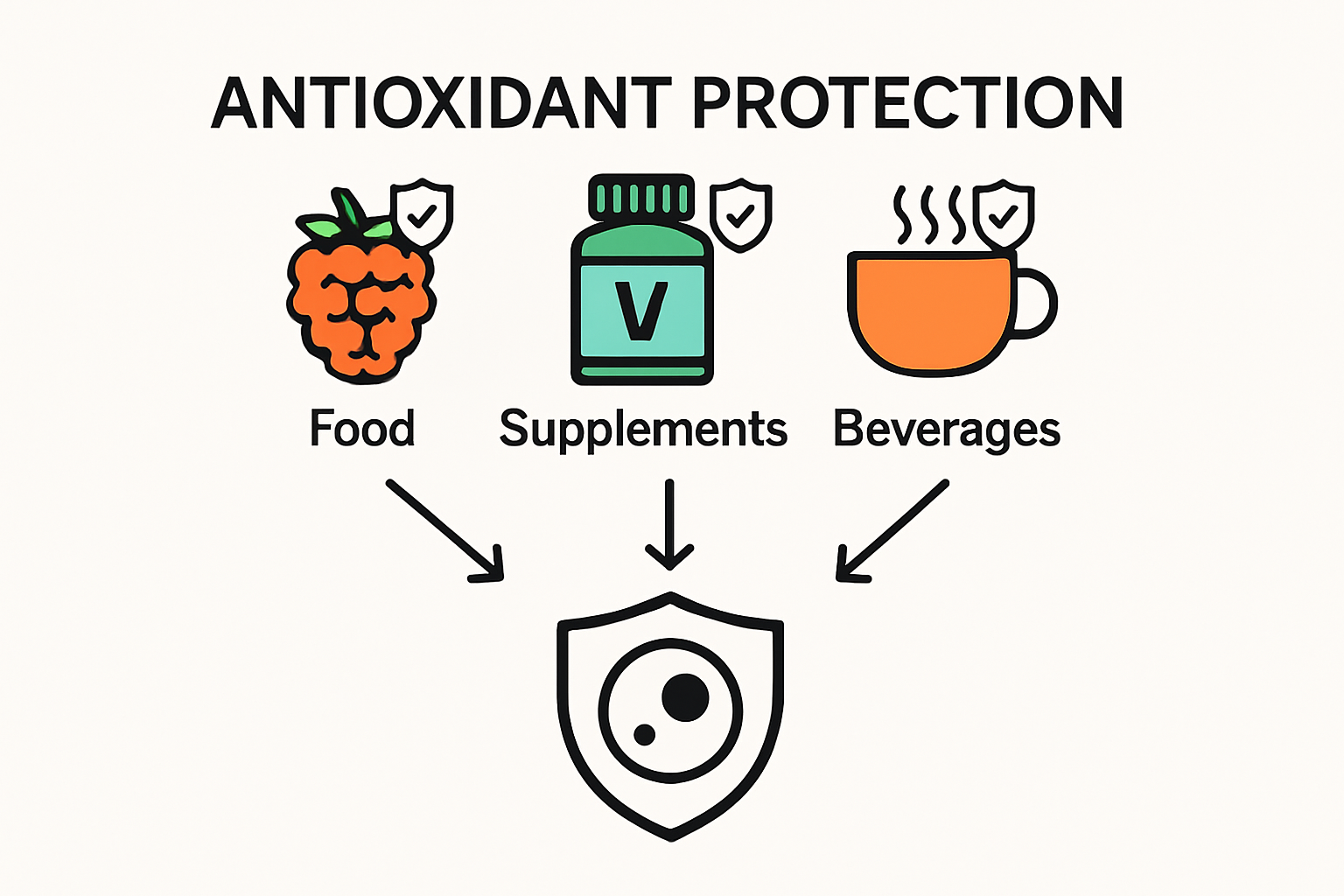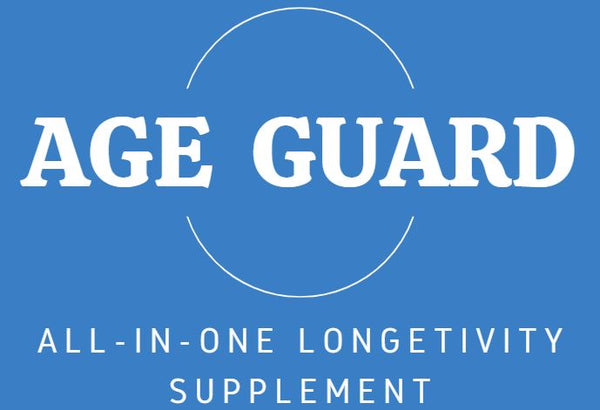
Understanding the Benefits of Antioxidants for Health
Share
Antioxidants do way more than keep fruits from turning brown. Scientists have found that these tiny molecules protect every cell in your body from invisible threats that can speed up aging and increase disease risk. But while most people think getting a handful of berries is enough, the real surprise is that key antioxidants like vitamins C and E, beta carotene, and selenium work together in a much more powerful way than any one alone. The secret to staying healthier and younger for longer might be hiding in how these molecules team up.
Table of Contents
- What Are Antioxidants And Their Role In The Body?
- Why Antioxidants Matter For Longevity And Aging
- How Antioxidants Protect Against Cell Damage
- Key Sources Of Antioxidants For Better Health
- The Practical Impact Of Antioxidants On Energy And Skin
Quick Summary
| Takeaway | Explanation |
|---|---|
| Antioxidants neutralize free radicals. | They donate electrons to free radicals, preventing cellular damage and maintaining balance. |
| Sources include vibrant plant foods. | Berries, leafy greens, nuts, and dark chocolate are rich in antioxidants, supporting cellular health. |
| Antioxidants support energy production. | They protect mitochondria, enhancing efficient energy metabolism and reducing oxidative stress. |
| They help maintain skin health. | Antioxidants combat collagen breakdown and inflammation, promoting youthful, elastic skin. |
| Strategic intake may extend lifespan. | Regular consumption of antioxidants can slow aging effects and reduce chronic disease risks. |
What Are Antioxidants and Their Role in the Body?
Antioxidants are powerful molecular defenders that protect your body from harmful damage caused by free radicals. According to Harvard T.H. Chan School of Public Health, these substances play a critical role in maintaining cellular health and preventing potential disease progression.
Understanding Free Radicals and Oxidative Stress
Free radicals are unstable molecules that can cause significant damage to your cells through a process called oxidative stress. These highly reactive compounds are produced naturally during metabolic processes and can also result from external factors such as:
- Environmental pollution
- Cigarette smoke
- Ultraviolet radiation
- Processed foods
- Intense physical activity
When free radicals accumulate faster than your body can neutralize them, they create an imbalance that leads to cellular damage. This damage contributes to accelerated aging and increases risks for chronic diseases like cancer, diabetes, and heart conditions.
This table summarizes the most common sources of free radicals that contribute to oxidative stress and the resulting types of cellular damage associated with aging and disease.
| Source of Free Radicals | Example Exposure | Type of Cellular Damage |
|---|---|---|
| Metabolic processes | Natural body metabolism | DNA/RNA mutations |
| Environmental pollution | Car exhaust, industrial fumes | Lipid peroxidation in membranes |
| Cigarette smoke | Direct or secondhand smoke | Protein degradation |
| Ultraviolet radiation | Sun exposure | Accelerated skin aging |
| Processed foods | Preservatives, additives | Increased inflammation |
| Intense physical activity | Long-duration, high-intensity exercise | Temporary oxidative overload |
How Antioxidants Protect Your Cellular Health
Antioxidants function as molecular shields, neutralizing free radicals by donating electrons without becoming destabilized themselves. This process prevents the chain reaction of cellular damage and helps maintain your body’s natural defense mechanisms. Key antioxidants include vitamins C and E, beta carotene, and minerals like selenium, which work synergistically to protect different parts of your cells.
By understanding the role of antioxidants in immunity, you can appreciate how these remarkable molecules support your overall health and help combat age-related cellular deterioration.
To clarify how major antioxidants work within the body and their specific roles, the following table outlines key types, their main functions, and typical sources.
| Antioxidant | Main Function | Common Food Sources |
|---|---|---|
| Vitamin C | Neutralizes free radicals, supports immunity | Citrus fruits, berries, bell peppers |
| Vitamin E | Protects cell membranes, prevents lipid oxidation | Nuts, seeds, leafy greens |
| Beta Carotene | Defends DNA and skin cells, precursor to vitamin A | Carrots, sweet potatoes, spinach |
| Selenium | Aids antioxidant enzyme function, supports cellular repair | Brazil nuts, seafood, eggs |
| Coenzyme Q10 | Supports mitochondrial energy and cell protection | Fish, meat, whole grains |
Why Antioxidants Matter for Longevity and Aging
Antioxidants are more than just nutritional buzzwords they are critical players in the complex process of aging and cellular preservation. Research from the International Journal of Molecular Sciences reveals that antioxidants play a fundamental role in mitigating oxidative stress, which is a primary mechanism underlying age-related cellular deterioration.
The Aging Process and Cellular Damage
As we age, our body’s natural ability to combat oxidative stress diminishes, creating a cumulative effect of cellular damage. This progressive deterioration impacts multiple biological systems and contributes to what we recognize as aging. Key physiological changes associated with oxidative stress include:
- Reduced mitochondrial efficiency
- Increased inflammation
- Compromised cellular repair mechanisms
- Accelerated telomere shortening
- Decreased immune system responsiveness
These changes not only affect how we look but fundamentally influence how our body functions at the cellular level. The gradual accumulation of oxidative damage can lead to decreased energy, slower recovery, and increased vulnerability to chronic diseases.
Antioxidants as Cellular Guardians
Antioxidants serve as critical defenders against this aging process by neutralizing free radicals and supporting cellular resilience. They work through complex mechanisms that protect DNA, proteins, and lipids from oxidative damage. By exploring superfoods for aging, you can discover natural sources that provide powerful antioxidant protection.
While aging is an inevitable biological process, strategic antioxidant intake can potentially slow down its most detrimental effects, promoting a more vibrant and healthy lifespan. Consistent antioxidant support may help maintain cellular health, potentially extending both lifespan and healthspan—the period of life spent in good health.
How Antioxidants Protect Against Cell Damage
Cell damage represents a fundamental mechanism through which aging and disease progression occur, making antioxidants critical molecular defenders. Research from the National Institutes of Health demonstrates how these powerful compounds interrupt destructive cellular processes and maintain biological integrity.
The Molecular Mechanism of Cellular Protection
Antioxidants work through a sophisticated electron donation process that neutralizes free radicals before they can cause widespread cellular damage. This protective mechanism involves several key interactions:
- Interrupting oxidative chain reactions
- Preventing lipid peroxidation in cell membranes
- Stabilizing molecular structures within cells
- Reducing inflammatory responses
- Supporting DNA repair mechanisms
By preventing free radical accumulation, antioxidants help maintain the structural and functional integrity of cellular components. This protection is particularly crucial for critical cellular structures like mitochondria, which generate energy and play a central role in overall cellular health.
Types of Cellular Damage Prevention
Antioxidants provide comprehensive protection across multiple biological systems. They defend against different types of cellular damage by neutralizing various free radical forms and supporting metabolic processes. Learn more about cellular health boosters to understand the broader context of cellular protection.
Comprehensive cellular defense involves preventing damage to proteins, lipids, and genetic material, ensuring that cells can function optimally and resist premature aging. By maintaining this delicate molecular balance, antioxidants play a crucial role in supporting long-term health and reducing the risk of chronic diseases associated with oxidative stress.
Key Sources of Antioxidants for Better Health
Clemson University’s Home & Garden Information Center highlights that antioxidant sources are diverse and abundant in nature, offering multiple pathways to enhance cellular protection and overall wellness. Understanding these sources empowers individuals to make strategic dietary choices that support long-term health.
Natural Food Sources of Antioxidants
Antioxidants are predominantly found in plant-based foods, with their concentration often indicated by vibrant colors. The most potent antioxidant sources include:
- Berries (blueberries, strawberries, raspberries)
- Dark leafy green vegetables
- Nuts and seeds
- Colorful vegetables like bell peppers and sweet potatoes
- Green and black tea
- Dark chocolate with high cocoa content
- Herbs and spices like turmeric and oregano
Each food category offers unique antioxidant compounds that target different cellular processes. The diversity of these sources ensures comprehensive protection against oxidative stress and supports multiple biological functions.

Supplemental Antioxidant Options
While whole foods remain the primary recommendation, understanding the impact of antioxidants on skin can help individuals explore targeted supplementation strategies. Specific antioxidant supplements can provide concentrated protection, including vitamins C and E, selenium, and specialized compounds like coenzyme Q10.
The key is balanced consumption and understanding that no single antioxidant can provide complete cellular defense. A varied, nutrient-rich diet combined with mindful supplementation offers the most comprehensive approach to maintaining cellular health and combating age-related oxidative damage.
The Practical Impact of Antioxidants on Energy and Skin
Research from the journal Antioxidants reveals the profound connection between antioxidant intake and physiological performance, demonstrating their critical role in maintaining both energy levels and skin health. Understanding these practical impacts can transform how we approach nutrition and cellular protection.
Antioxidants and Cellular Energy Production
Mitochondrial function is directly influenced by antioxidant availability, which plays a crucial role in energy metabolism. When free radicals overwhelm cellular defenses, energy production becomes compromised. Key energy-related benefits of antioxidants include:
- Reducing oxidative stress in mitochondria
- Supporting efficient metabolic processes
- Enhancing cellular repair mechanisms
- Preventing premature cellular aging
- Maintaining consistent energy metabolism
By protecting mitochondrial structures, antioxidants help maintain consistent energy levels and prevent the metabolic slowdown associated with oxidative damage. This protection is particularly important as we age and our natural cellular repair mechanisms become less efficient.
Antioxidants and Skin Health Transformation
Understanding the impact of antioxidants on skin reveals their remarkable ability to combat visible signs of aging. Skin health is a direct reflection of cellular protection, with antioxidants serving as critical defenders against environmental damage.
Antioxidants work by neutralizing free radicals that cause collagen breakdown, inflammation, and premature aging. This process helps maintain skin elasticity, reduce wrinkle formation, and support a more youthful appearance. The result is not just cosmetic but represents a deeper level of cellular preservation and protection.

Unlock Real Antioxidant Power for Your Health
You have just learned how antioxidants protect your cells, restore energy, and help maintain youthful skin. Yet finding a clinically backed solution that brings these benefits together is not always easy. Free radical damage, oxidative stress, and aging do not wait. So why should you?

Experience what advanced antioxidant and cellular support can do for you. Age Guard features research-driven ingredients like NMN, collagen, spermidine, and potent antioxidants. Each dose is crafted to bolster immunity, fight cellular aging, and help you reclaim healthy energy. See detailed ingredient science, read reviews, and secure special savings today at MyAgeGuard.com. Do not just read about theories—act now to support your body’s defenses and take meaningful steps toward healthier aging. Visit our Home page to get started.
Frequently Asked Questions
What are antioxidants and how do they work in the body?
Antioxidants are molecules that protect your body from damage caused by free radicals. They neutralize free radicals by donating electrons, preventing further cellular damage and supporting overall health.
How do antioxidants influence the aging process?
Antioxidants play a crucial role in mitigating oxidative stress, which contributes to age-related cellular deterioration. By neutralizing free radicals, they help maintain cellular health and potentially extend lifespan and healthspan.
What are some natural food sources rich in antioxidants?
Natural food sources of antioxidants include berries, dark leafy greens, nuts, colorful vegetables, green and black tea, and dark chocolate. These foods provide various antioxidant compounds that support different cellular functions.
Can antioxidant supplements be beneficial for health?
Yes, antioxidant supplements can provide concentrated protection, especially for specific nutrients like vitamins C and E, selenium, and coenzyme Q10. However, a varied diet rich in whole foods is the best approach for comprehensive cellular defense.
